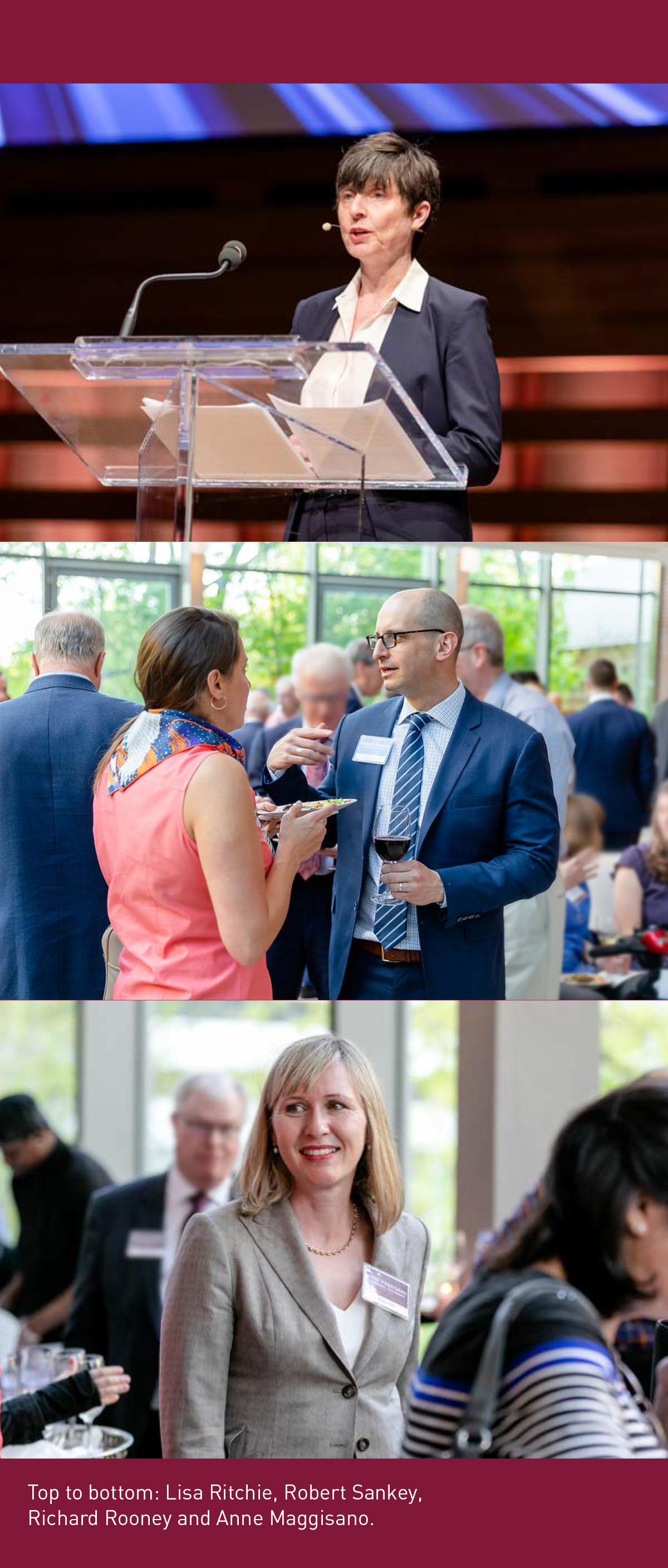Anne Maggisano and Lisa Ritchie delivered the following speech at the Burgundy Annual Forum on May 23, 2019.
A married woman, a mother, a grandmother, the CEO of her family’s foundation. Seeking the best thinking around investing so that she can prudently steward her family’s wealth and make an impact on others less fortunate.
A young mother, 40 years of age. Educating herself and building her network of advisors so that she is prepared for the inevitable transfer of wealth to herself and to her siblings.
A colleague, a husband, a father. Sharing research reports with us on the status of women and investing, supporting our mission of inspiring women to make investing a priority.
A woman, recently widowed. Actively seeking knowledge and engaging her trusted legal and financial advisors so that she can confidently take care of herself.
A colleague, a father, a chairman. Introducing us to senior women in business and investing, the women who have blazed the trail for us, and, in doing so, charted a course for generations of women to follow.
A young woman in the investment industry. Seeking to understand the social, cultural and historical norms that made her falsely believe that investing was exclusively a man’s role.
What do all these individuals, each with their own unique circumstances, have in common? They are all members of the Women of Burgundy community. It may be hard to believe from our modern-day vantage point that women’s ability to independently grow wealth has been constrained by our past. But let’s take a brief look at recent North American history.
 It was not until 1977 that the Canadian Human Rights Act introduced equal opportunity, ruling discrimination based on gender, marital and family status illegal.1 And until 1978, women in the U.S. could legally be dismissed from their jobs for becoming pregnant. This made having a family or building wealth an either/or proposition. And prior to 1974 in the U.S., single, widowed or divorced women did not have access to credit. No matter what their income was, they needed a co-signer, and the banks would discount the value of the applicants’ wages by as much as 50% when deciding how much credit to grant.2 Although women could legally own property, and they had access to the stock market by this time, the constraints around the ability to earn income and to access credit made it unlikely that women would be active investors. It normalized the idea that investing should exclusively be a man’s role.
It was not until 1977 that the Canadian Human Rights Act introduced equal opportunity, ruling discrimination based on gender, marital and family status illegal.1 And until 1978, women in the U.S. could legally be dismissed from their jobs for becoming pregnant. This made having a family or building wealth an either/or proposition. And prior to 1974 in the U.S., single, widowed or divorced women did not have access to credit. No matter what their income was, they needed a co-signer, and the banks would discount the value of the applicants’ wages by as much as 50% when deciding how much credit to grant.2 Although women could legally own property, and they had access to the stock market by this time, the constraints around the ability to earn income and to access credit made it unlikely that women would be active investors. It normalized the idea that investing should exclusively be a man’s role.
How far we have come since then! According to Credit Suisse’s 2018 Global Wealth Report, women control C$95 trillion of financial assets, approximately 40% of the total.3 You may have seen the CIBC report released in March of this year.4 It outlined the fact that women in Canada control C$2.2 trillion of financial assets. That’s quite a lot of money. In fact, it’s estimated that in 10 years, this number will be closer to C$3.8 trillion.
We are on the cusp of an historical moment for women and investing. Advances in the labour market are playing a huge role. Women are entering higher-paying fields and starting their own businesses, and their success rate is growing. We are seeing the breakdown of the nuclear family, and women are choosing to take their own lead in building wealth. Demographics also play a huge part here. We know that, on average, women live five years longer than men. And when it comes to taking care of aging parents, it tends to be the daughter who takes the lead role. That means she’s controlling the decisions around wealth for her parents. Current data from Strategic Insight projects that at some point in their lifetime, nine out of 10 women will be the sole financial decision-maker in their families.5
This is where Women of Burgundy comes in, as a bridge between a past that need not define us and a future that is imminently near. Women of Burgundy is preparing our women clients to meet their futures, and we are doing so by creating the conditions and the culture that will enable women to thrive and to reach their full potential as investors.
What we are doing and what we are building is not the norm. We have canvassed the Canadian landscape, and we are the first investment firm to chart this path with this level of commitment. We are choosing to nurture the women in our community because the women we educate today will educate the women in their own lives—their mothers, daughters, sisters, friends and communities— and this will have ripple effects for generations. The women in our community will also influence the men in their lives, their fathers, sons, husbands and brothers, and, in doing so, reframe the narrative around women’s roles and men’s roles as it relates to investing. Having women and men equally empowered around money is good for society and good for all of us. That’s hard to dispute.
How are we doing our work? We are building a culture in which women are active agents in their own learning about investing. Wherever she is on her journey, whether she be a novice investor or a sophisticated investor, the women in our community are engaging in our seminars, our book clubs, our keynote speaker events, because they want to learn and they want access to the best thinking around investing. This learning is coming from direct contact with professionals. It is also coming from reading the ideas of the investing greats of our time. They are learning to exercise discernment, to think for themselves, and, as such, are becoming agents in their own financial independence.
Women are also telling us that they are participating in Women of Burgundy because they value the safety and strength that comes from community. One woman told me that her growth has been accelerated because she is able to tap into the knowledge, the skills and the life experiences of other members of the community. She also told me that she is building her network now so that she will be more resilient in the face of the inevitable challenges to come. She knows the Women of Burgundy network is a resource that she will be able to access when she can’t find the answers herself.

Since our launch in April 2014, Women of Burgundy has reached over 730 members, both women and men. We have built a deep and strong community of over 250 members who come to our events regularly. Just last month, we launched the first issue of Minerva, our Women of Burgundy magazine. We did this so we could accelerate our potential impact to include 100% of our clients, both women and men. Upon receiving a copy of Minerva, a peer in our industry wrote to us and commended Burgundy for elevating the conversation around investing from woman to woman. We couldn’t be more thrilled with this response. As Sally Ride, the first woman astronaut, teaches: we can’t be what we can’t see. By elevating all the women in our community, both Burgundians and our clients, we are acting as role models for each other of how an empowered woman thinks and behaves when it comes to money and to investing.
The transformation we are seeing with our women clients is being matched by an equal transformation within Burgundy. When Women of Burgundy was launched in 2014, there were five female investment professionals responsible for our private and institutional clients. That represented about 35% of our team. That number has grown to 10 and is now 42% of our 24-person client-relationship team. And when we look at the next generation, we are so excited to see that we have seven young women in training for more senior client-relationship roles. As the women professionals at Burgundy grow and succeed, they will inevitably support and reinforce the growth and development of our women clients. The men at Burgundy are co-champions of this growth and development. The result is that our team is better able to access a broad and diverse range of thinking, and that will benefit all of our clients.
The work that we are doing with Women of Burgundy is designed to support and complement the work that is happening one-on-one in our client meetings. These meetings give us a front-seat perspective on how our women clients invest. We want to take some time to specifically address some common myths around women and investing. These myths suggest that women are more risk-averse than men; that only men care about investment returns and women less so; that only women require being spoken to in a language that avoids jargon. We strongly believe that these ideas cause more harm than good for the simple reason that they are not a true reflection of our experiences as advisors. They also completely miss the point. In our experience, and from our observations, both women and men care equally about investing in a manner that aligns with their long-term goals for their money, with the associated risk and return considerations.
When we are devising an investment strategy with our clients, our goal is always to value the infinite uniqueness, the depth and the complexity of each individual person and to meet each individual on his or her terms. Contrary to the idea that men and women are different when it comes to investing, we propose that there are certain characteristics and qualities that are common to successful investors. Qualities like a contrarian mindset, long-term thinking and a philosophical framework for making decisions. These qualities can be found equally in men and women. And they can be nurtured equally in men and women. That is to say, we believe nurture more than nature will determine individual success as an investor.
1. “Rights of Women,” 2017. September 5, 2019. https://www.canada.ca/en/canadian-heritage/services/rights-women.html
2. McGee, Suzanne and Moore, Heidi. “Women’s rights and their money: a timeline from Cleopatra to Lilly Ledbetter,” 2014. September 5, 2019. https://www.theguardian.com/money/us-moneyblog/2014/aug/11/women-rights-money-timelinehistory
3. Credit Suisse Group AG, Global Wealth Report 2018 (Zurich, Switzerland: 2018)
4. Tal, Benjamin and Katherine Judge, The Changing Landscape of Women’s Wealth (CIBC Economics March 4, 2019)
5. Strategic Insight, Women and Wealth (2017)
This publication is presented for illustrative and discussion purposes only. It is not intended to provide investment advice and does not consider unique objectives, constraints or financial needs. It is not intended as an offer to invest in any Burgundy investment strategies. Under no circumstances does this publication suggest that you should time the market in any way or make investment decisions based on the content. Select securities may be used as examples to illustrate Burgundy’s investment philosophy. Research used to formulate opinions was obtained from various sources and Burgundy does not guarantee its accuracy. Forward-looking statements are based on historical events and trends and may differ from actual results. Any inclusion of third-party books, articles and opinions does not imply Burgundy’s endorsement or affiliation. The information in this publication is as of the date of the publication and will not be revised or updated to reflect new events or circumstances.
